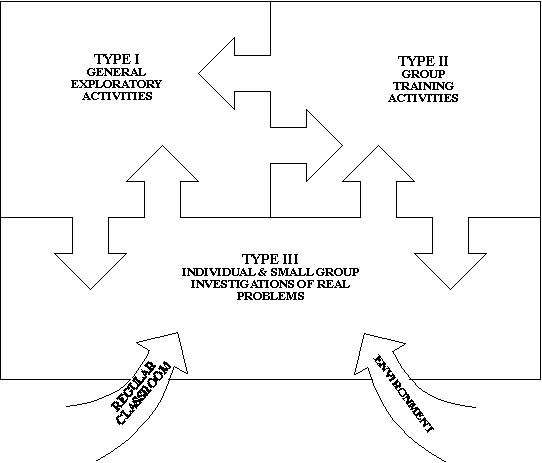The Enrichment Triad Model was designed to encourage the creative productivity of young people by exposing them to various topics, areas of interest, and fields of study, and to further train them to apply advanced content, process-training skills, and methodology training to self-selected areas of interest. Accordingly, three types of enrichment are included in the Triad Model (see Figure 1).
- Type I enrichment is designed to expose students to a wide variety of disciplines, topics, occupations, hobbies, persons, places, and events that would not ordinarily be covered in the regular curriculum. In schools that use this model, an enrichment team consisting of parents, teachers, and students often organizes and plans Type I experiences by contacting speakers, arranging mini-courses, demonstrations, or performances, or by ordering and distributing films, slides, videotapes, or other print or non-print media.
- Type II enrichment consists of materials and methods designed to promote the development of thinking and feeling processes. Some Type II training is general, and is usually carried out both in classrooms and in enrichment programs. Training activities include the development of (a) creative thinking and problem solving, critical thinking, and affective processes; (b) a wide variety of specific learning how-to-learn skills; (c) skills in the appropriate use of advanced-level reference materials; and (d) written, oral, and visual communication skills. Other Type II enrichment is specific, as it usually involves advanced methodological instruction in an interest area selected by the student.
- Type III enrichment involves students who become interested in pursuing a self-selected area and are willing to commit the time necessary for advanced content acquisition and process training in which they assume the role of a first-hand inquirer. The goals of Type III enrichment include:
- providing opportunities for applying interests, knowledge, creative ideas and task commitment to a self-selected problem or area of study,
- acquiring advanced level understanding of the knowledge (content) and methodology (process) that are used within particular disciplines, artistic areas of expression and interdisciplinary studies,
- developing authentic products that are primarily directed toward bringing about a desired impact upon a specified audience,
- developing self-directed learning skills in the areas of planning, organization, resource utilization, time management, decision making, and self-evaluation, and
- developing task commitment, self-confidence, and feelings of creative accomplishment
Next Section: Using the Compactor to Facilitate Curriculum Compacting
Previous Section: Background Information on Compacting
